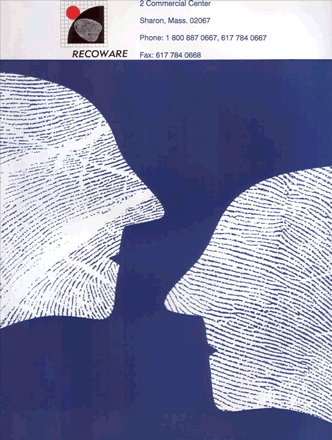
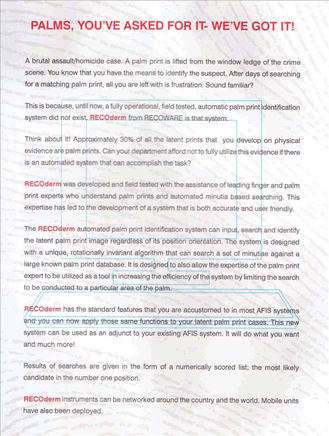
.jpg)
References
Borsod-Abaúj-Zemplén County Police Headquarters Miskolc
Jász-Nagykun-Szolnok County Police Headquarters Szolnok
Győr-Moson-Sopron County Police Headquarters Győr
Research Institute for Forensic Sciences Budapest
National Training Center, Durham, Great Britain
Royal Police of Thailand Bangkok Thailand
Lockheed Martin Co.
Recoderm – scourge of the criminals
Hungarian system for identification of TP cards and palmprints
Rob Luké (Budapest Sun) to NÉPSZAVA
A group of Hungarian IT professionals transferred to law enforcement: they came out with a system that raises Hungary to the forefront of the struggle against criminals. The Recoderm high-technology system for identification TP cards and palmprints will soon become scourge of criminals. Recoware Kft., founded in the framework of the Central Research Institute for Physics (KFKI) recently signed an agreement with the National Police Headquarters (ORFK) on application of the system that already proved to be successful in the country.
“Via the Recoderm system, the local policemen can send any print over directly to the database, for identification. This facilitates and accelerates capture of the criminals” - says András Molnár, sales manager of Recoware.
It was back in 1991, that a group of scientists of KFKI looked after a practical application for their high efficiency parallel data processing system, and the ORFK just then announced a tender for a fingerprint identification system. The scientists modified their system according to the requirements by December 1993, but they missed the tender’s deadline. Recoderm, however, gave such a good impression that it was applied at the Police Headquarters of Szolnok County for a two year’s trial period. Based on the results here, Recoderm got the green light from ORFK to a county-wide introduction.
The system is extremely simple: latents found at the crime scene are compared to TP cards of criminals registered in the database and Recoderm puts together the list of possible suspects. After examining the TP card images, the dactyloscopic expert points to the perpetrator. It can happen that the computer “names” only a single suspect.
Likewise, one of the really attractive features of Recoderm is its accuracy. The system finds the perpetrator at the first approach in 95% of the cases - says András Molnár proudly. A further strength of the system is its portability. Images appearing in the special van can be transmitted by radio to the database, from where list of the suspects will be re-transmitted to the van.
The most important thing Recoware can boost about is that it accurately identifies the criminals also from the palmprints. Although it is a worldwide practice that police forces make a catalogue of the palm latents collected at the crime scenes, identification of them is extremely difficult. And only partial palm latents can be found at the crime scene at one third of all criminal cases. On the other hand, Recoderm identifies the suspect based on the tiniest latent of any part of the hand.
“According to our knowledge, not one of the world’s print identification systems can do that” - remarks sales manager of Recoware
In Szolnok county, the system was extremely effective in 35% of the break-in, robbery, car theft cases. “A small refinement yet and Recoderm will be brilliant, every police authority will need it” - states Pál Tóth, head of the criminology department of the county police.
András Molnár told that foreign law enforcement organizations, especially police forces of the United Arabic Emirates, Dubai and Kuwait, but also authorities in Western and Central Europe, showed interest in the system. But to break in to the export market will be just as difficult as to wear down the criminal gangs, that Recoderm helps identify. Hungarian firms have to count on competition of bigger systems of French, American and Japanese companies.
“We regard ourselves pioneers in the area, but regrettably we are tiny pioneers in an extremely large area” - said András Molnár.
Call for your free copy today! 268-1101/1102/1104 FAX 268-1103
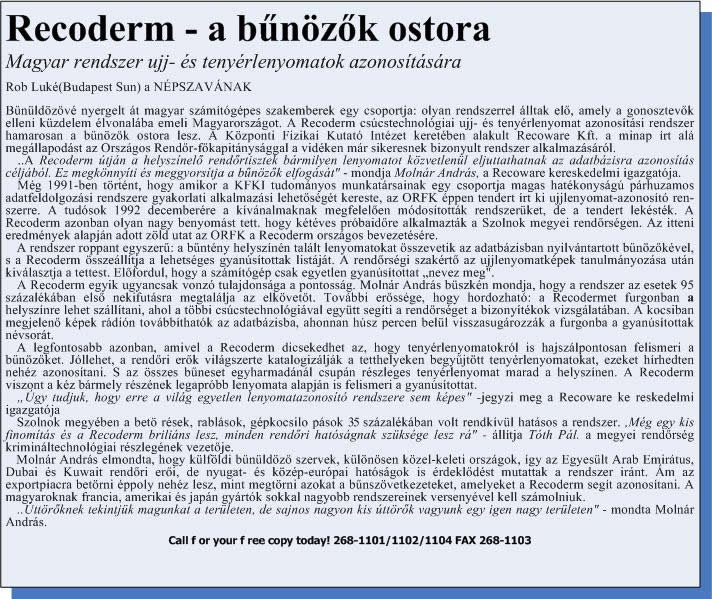
.jpg)
Development of the RECOderm computerized dermatoglyphic identification system began in 1990 at the Central Research Institute for Physics of HAS (MTA KFKI; HAS: Hungarian Academy of Sciences). The Institute was the largest research institute in Central Europe with a wide range of activities, including particle and nuclear physics, research of nuclear energy and space and also IT research/development The RECOderm development project launched in 1990 relied on results obtained in these areas. RECOderm utilized the research results of high energy particle physics to a great extent, as well as those of high performance parallel computer architectures.
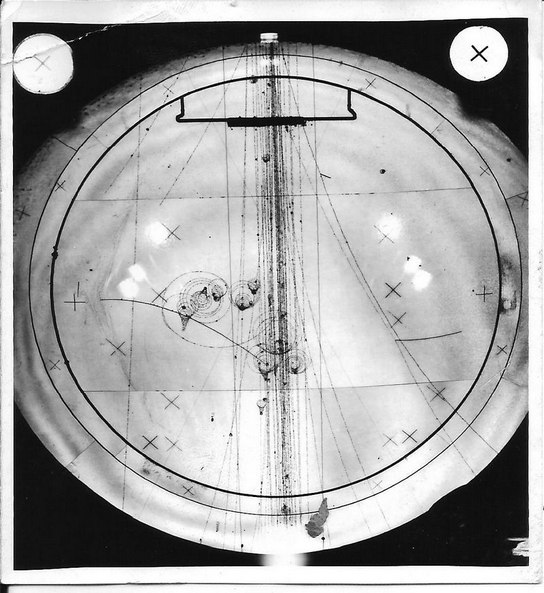
Basis of the RECOderm system’s feature extraction subsystem was the pattern recognition algorithm developed for evaluation of bubble chamber recordings taken in the high energy particle physics research.
Three programs can be pointed out of the IT results that were determining in the development of RECOderm.
One of them as the VEGA program for observation of the Halley comet. The VEGA space probe followed the Halley comet successfully all the time by the system developed and implemented by the Institute.
The other is the safety and supervision system implemented at the PAKS nuclear reactor, as well as the reactor simulating and training/practicing system which is unique in Central and Eastern Europe even today.
Development of the third TPA XP-1 multiprocessor mini-super computer
The RECOderm system had been applied by the Hungarian Police since 1992; based in the one-year experience in the practice they decided on the countrywide introduction of the system. Upon its operation, the system justified the expectations.
The RECOderm computerized dermatoglyphic identification system was established by the utilization of all these prominent research & development results, as well as the most up-to-date IT devices. This overpointed the AFIS systems of conventional approach, as in addition to fingerprint latents it was also capable of identifying palm latents. In developing the system, RECOWARE closely cooperated with the Jász-Nagykun-Szolnok County Police Headquarters; they considered demands of the police work and the complex requirements of the criminal work. A system could be created the user interface of which was formed by many years of police practice.
In the police experience, RECOderm was the first and up to 2000 the only system by which perpetrators could be identified based on a palm latent.
By its inexpensive remote latent entry stations and by means of the communication infrastructure of Jász-Nagykun-Szolnok county, it enabled the perpetrator from a small town to be identified for the crime scene investigation group in 15 minutes following lifting of the latent.
Development of the RECOderm system was started by one of the research institutes of MTA KFKI, the Research Institute for Measurement and Computing Techniques (Mérés- és Számítástechnikai Kutatóintézet, MSZKI). After the organizational and economical reorganization, development activities were concentrated by MTA KFKI in the RECOWARE Kft. (Coworkers of the Kft. participated in the IT projects mentioned earlier.) The Ltd. was the first in the world to develop the palmprint identification procedure, in 1992.
Next year, Hungarian Police decided – after several tests (one of which was performed by the New Scotland Yard) – on the countrywide introduction of the RECOderm system. In addition to the one operating in Szolnok, in 1994 three other regional systems were applied in the exploratory work.
After the favorable benchmark tests of Ron Smith, the American palmprint specialist, in 1997 Lockheed Martin Co. bought the finger/palmprint technology embodied in the RECOderm system, together with its patent.
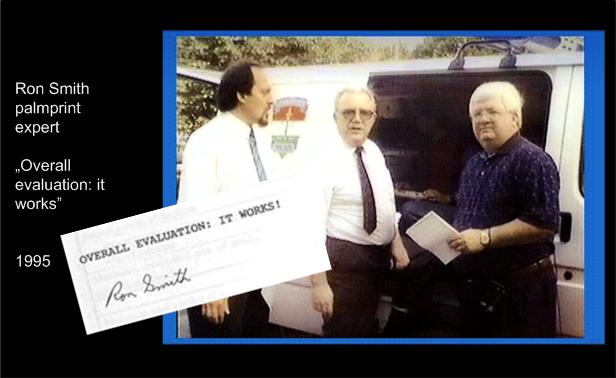
RECOderm, 1994 (part of a 1994 RECOderm information sheet)
The RECOderm system has several features that are special in the AFIS (Automatic Fingerprint Identification System) technique and provides significant advantages in efficiency of the everyday practical work. It involves inventions applied in 10 countries – these are still patent pending procedures.
The RECOderm system automatically classifies the TP cards by type. The RECOderm system is able to identify palmprints, too. Considering that in daily practice approx. one third of the unknown on-the-scene latents come from a palm, this can increase efficiency of the exploration by one and a half.
The RECOderm’s feature extraction (dactyloscopic minutia recognition) algorithm, its efficiency is of prominent quality. This makes possible that the TP card entry could happen even without an expert contribution in the daily work. This way the expert has to deal only with the expert’s work. Thereby operation of the system can be realized with fewer expert staff numbers.
The RECOderm system is capable of reading the unknown on-the-spot traces directly from the foils, whereby workload of the expert is further eased. There is no need to the pre-processing photo procedures and the graphic editing during the expert processing
RECOderm provides universal expert workstations at such low prices, that each expert can as well have one at his/her desk.
The RECOderm system applies only the “open system” devices conform to the international standards. It does not use proprietary hardware, hence it can take device preferences of the future customer into account and it offers a system built with the most up-to-date, newest hardware products. Further, this ensures the easy in-site upgradability, causing no stoppages in daily work. As the IT devices have increasingly good price/performance ratio and upgrading of the system is very simple, the user does not have to make efforts to accumulate the unnecessary reserves, thus introductory price of the system can be very low.
The RECOderm system makes possible an identification with rotational invariance. This means that there is no need to orient the traces according to a core axis. The knowledge or lack of knowledge of the core axis involves no advantages or disadvantages.
The RECOderm system does not use favored points (core, delta) to the identification. Thereby it can perform identification of small finger and palmprint fragments, too.
It is adapted to the international recommendations, which provide for a compatibility at the image level and an electronic data exchange.
The inexpensive, direct TP card reading devices of the RECOderm system without inking enable the border stations or even police cars to determine whether the particular person would be present in the repository. This means a great advantage for the immigration authorities.
The RECOderm system, with its simply designed Remote Latent and TP Card Entry Stations provides a wide area coverage. Latents are transmitted electronically, not in a conventional way (courier, mail). Hereby it shortens the one or two days passed from recording of the latent until identification of it to one hour. This has an outstanding significance in the criminal work.”
part of a 1994 RECOderm information sheet
"RECOderm technology"
(Fingerprint Whorld, 1996)